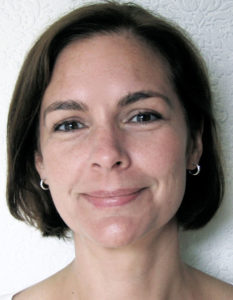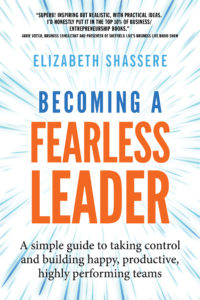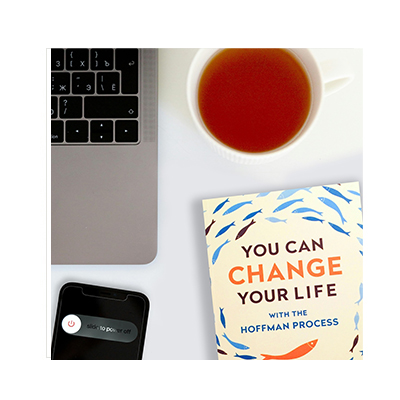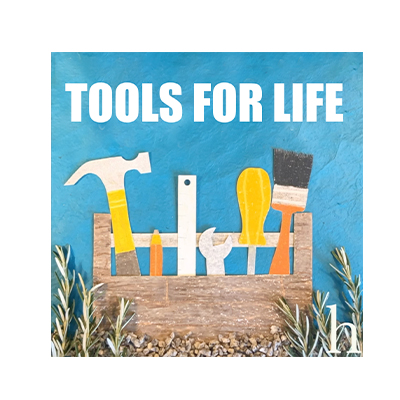 Over the past 20 years Elizabeth Shassere has led teams through transformation and improvement in organisations ranging from large government agencies to startups. She’s currently founder and CEO of Textocracy Ltd. Her first book, Becoming a Fearless Leader: A simple guide to taking control and building happy, productive, highly-performing teams is receiving excellent reviews.
Over the past 20 years Elizabeth Shassere has led teams through transformation and improvement in organisations ranging from large government agencies to startups. She’s currently founder and CEO of Textocracy Ltd. Her first book, Becoming a Fearless Leader: A simple guide to taking control and building happy, productive, highly-performing teams is receiving excellent reviews.
How I became a fearless and authentic leader
I found myself thrust into a director-level position in my chosen profession almost by accident very early in my career. Suddenly I was at the top of my field with decades of hard graft stretching in front of me until I retired.
I couldn’t imagine anything worse, but I couldn’t imagine anything different either.
I knew there had to be a better way, but what was it? I was working in a high-pressure environment, and in a dysfunctional organisational culture.
I didn’t like the way my job made me feel, nor the leader I saw myself becoming. I was also losing my best skills and abilities as I fought fires and battled an inflexible bureaucratic system.
Some personality assessments say that under stress your coping skills go out of the window and your character flaws take over your thinking. I certainly found this happening to me.
I was in a tough job in a tough sector. I was working harder and harder because I wanted the system to work for the people I was in the job to serve – the people who lived in my community. Being a stubborn, driven completer-finisher, I just hoped if I kept chipping away it would all come right in the end.
The day it changed
Then one day it dawned on me that it really wouldn’t. I was wasting my life beating my head against the proverbial brick wall. I wasn’t making a difference at all. Not only was I getting a headache and a rectangular brick-mark across my forehead, but I was so busy determined to do the undoable that life was passing me by. I had to stop and look around.
This was serious. I was serious. I did not want to wake up at age 60 or 65 desperate to retire having spent thirty years knowing something was wrong but doing nothing about it.
I began to devise my grand plan to leave my career and start something else, anything, as long as it meant a totally new way of approaching life and my relationship to my work and purpose.
But I soon found there were two major obstacles to overcome before I could even devise a plan, much less put it into action:
- First of all, I couldn’t pinpoint the cause of my negative relationship to my work so I was worried I‘d move on to something else and repeat the problem.
- Secondly, I had a lot of ingrained thinking that seemed to leave no room for thinking big.
It didn’t happen overnight, but over the next few years I discovered what was making me unhappy.
Taking the blinkers off
At first I thought I just needed a new job. I was in such a blinkered state that I didn’t realise I didn’t have to replace like with like. Then I started to listen to random podcasts and do lots of random reading to see if any other topic or profession struck a chord. All that exploring paid off as each one gave me a new perspective, or a practical tool, or valuable information so that I began thinking differently about my working life and what I was doing with it.
Finally I quit that career, started a business, and wrote my first book. I also started to see that my strengths and value as a leader went well beyond the job title I’d given up.
 The two key tools
The two key tools
I started with two tools to help me with each of the obstacles I’d identified:
- The first was a tool to help me learn my aptitudes, those inbuilt strengths and skills that come naturally to me. Understanding these showed me why I was so miserable doing certain things and jazzed up doing others. It helped me better understand what job I’d be best suited to. I could see where the cards were stacked against my innate talents, which helped me stop beating myself up, telling myself I wasn’t trying hard enough. That had been exhausting.
- The second was a week’s residential course called the Hoffman Process designed to unpack the baggage that was holding me back from being able to change, grow and think differently. These are the things we learn over a lifetime about how things are ‘supposed’ to be, or that ‘you’re the smart one not the creative one’, or any manner of societal and familial brainwashing that happens to us all. The Hoffman Process motto is “…when you’re serious about change”. And boy oh boy, was I serious. It was time to shake that off.
For me, the Hoffman Process became my saving grace on a difficult journey. It interrupted my unproductive thinking, introduced new ways of looking at my life, and perhaps best of all, it helped me take the blinkers off and shine a big, bright light into my blind spots.
I opened up to a whole new way of seeing my life and what it meant to me. This leap in self-awareness meant I started reflecting on my experience as a leader: what I felt good about and what I’d have done differently.
I decided to write a book about what I‘d learned with the added value of what I considered the ‘enlightenment’ of seeing my true motivation and my true self that I’d gained from the Process. The result is: Becoming a Fearless Leader: A simple guide to taking control and building happy, productive, highly-performing teams
The Hoffman model also gave me the idea to create a simple tool to develop my leadership skills.
Everything I’d found previously to help me manage my teams and improve their performance was either complex or written in academic speak – or both. The ideas were also time consuming, or assumed that I had lots of money at my disposal for expensive consultants to come in and do the hard work for me.
But Hoffman had already shown me both how to find balance and how to troubleshoot problem areas of my life. It focuses on four areas that made practical sense to me:
- Spiritual – your best or unconditioned self: the essence of who you are without patterns
- Emotional
- Intellectual
- Physical
Could I apply this to a workplace environment? It turns out that these concepts fit perfectly.
Applying the model
In work areas where I’d had no idea how to start because problems felt so complex and out of control, translating this model and applying it to the job at hand broke it down and made it manageable.
Also I figured the last thing everyone needed on top of the burden of chaos was me imposing a jargon-filled MBA-style academic exercise on them, whereas this was much easier to convey to the team.
This is what happened:
- Spiritual became our Mission Statement, Values and Goals
- Emotional became the Culture of our team
- Intellectual became our access to and use of Knowledge (including staff skill sets) and Information
- Physical became our built Environment
I drew a chart that looked like this:
| Personal development | Team development |
|---|---|
| Spritual | Mission statement, values, goals |
| Emotional | Culture |
| Intellectual | Knowledge and information |
| Physical | Environment |
In my book, I describe and show, in a simple and clear way, how this model can be used in leadership to take control and build happy, productive, high-performing teams.
I was only able to do this thanks to the way Hoffman freed up my thinking and let me see my authentic self so that I could bring that to my leadership position. It set me up for the change that took me from working in an environment and role that was not suited to me to creating a life on my own terms that feels like my ‘right life’.
I won’t pretend this has been an easy journey but the intention and commitment has paid off beyond my greatest imaginings. The years since doing the Process in 2011 have been scary, intense, dynamic and fulfilling – and I wouldn’t trade them for anything.
I still have a long way to go. In fact, I’ve learned that I’m on a perpetual journey that’s both exciting and gratifying and I’m not looking for a destination.
I highly recommend taking the time to reflect on the design of your life. Consider the way it fits you or doesn’t, and explore why you’re living the way you are. Many of us fall into a life, often based on the messages we get from our family and the other people around us.
It takes effort, sometimes painful effort, to allow the scales to fall from our eyes and see that we want or need something different, but in my experience it’s beyond worth it. It rewards you in ways you can’t imagine before you start nor count once it’s happening.
Take a few minutes to ask yourself these questions and see what your answers reveal:
- Do you feel you’re living your ‘right life’ or do you feel the need for change?
- Have you ever considered whether your life is something you have fallen into or if have you created it with intention?
- If you’ve fallen into it, how happy and satisfied with it are you? Do you like the work you do? Do you enjoy your lifestyle?
- When you were a young adult (or as a young adult now) how did you envisage your life as a ‘grown up’? If you don’t have that life now, why is that? Did your family or someone around you tell me I couldn’t or shouldn’t have that?
- Do you see your whole life and your whole self? Or do you recognise that you may have blind spots that mean you make choices and act in certain ways without intention?
- If you’d like to make some changes, or at least examine your life and work and how it makes you feel, are you willing to take the time and energy to explore why things are the way they are and perhaps take steps to change them?
- What one thing will you do next to start exploring the idea of your ‘right life’? (This could be reading something by an inspirational leader, listening to a podcast on a topic you’ve never considered, or speaking to someone in your own community who lives a life that interests you or that you admire.)
I believe considering these questions and deciding to take action, like completing the Hoffman Process, helped me become a happier person and a better leader.
Whatever tools or methods you choose, I can’t recommend strongly enough giving yourself the gift of time for reflection and contemplation. Then take action! The journey is its own reward.
Visit Elizabeth’s website: elizabethshassere.com for more about her work and to access to a free pdf workbook that accompanies her book: Becoming a Fearless Leader: A simple guide to taking control and building happy, productive, highly-performing teams





 Sign up to receive monthly newsletters from Hoffman
Sign up to receive monthly newsletters from Hoffman